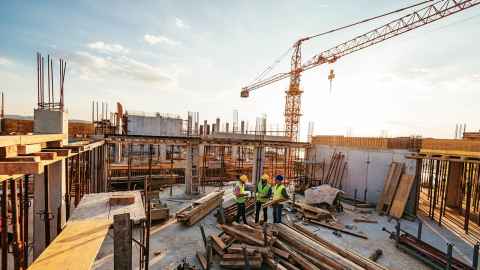Why big infrastructure projects are always over budget
24 March 2023
Opinion: Mega-projects like Auckland's City Rail Link are inherently risky. But with good planning and management they can be successful, explains Bevan Clement.

As New Zealand’s population increases, large infrastructure projects are required to meet existing and future demands.
Such projects are needed for both existing services, such as upgrading transport links and water services, and for new infrastructure projects, such as light rail, public transport, bridges, tunnels and expressways.
New Zealand is relatively new to mega-projects, and our expectations in regard to project performance relating to budget, schedule and realisable stakeholder benefits are critical to completing them successfully.
Unfortunately, it seems New Zealand is not unique in experiencing cost overruns and delays on large infrastructure projects. A survey of more than 3000 projects worldwide by Bent Flyvbjerg, an Oxford University authority on mega-projects, found 27% were on budget, less than 3% were on budget and on time and, astoundingly, only 0.2% were on target in terms of budget, time and realised benefits.
The reasons for cost increases
Large-scale projects contain increased uncertainty and complexity. For example, in Auckland, tunnelling for the City Rail Link (CRL) is undertaken in an underground environment where volcanic cones, lava flows, marine muds and geologically young and unstable materials are present.
While geotechnical investigation is carried out, it is impossible to remove the risk inherent in carrying out work beneath ground.
Construction delays and labour shortages will inevitably cause cost increases. Weather events, labour disputes, supply chain disruptions or working restrictions (e.g. Covid-19) will increase costs and extend project timelines. Recall the gib shortage in August 2022 when the price of gib ballooned to six times the retail price.
New Zealand should be making better use of available data on previous projects both from within and from overseas, which can better inform as to the likely cost and time required to complete a build.
As a small country, New Zealand needs to attract teams of highly skilled engineers and workers who are experienced in the construction of large infrastructure. This proved doubly difficult when borders were closed, and we were competing (and still are) against other countries.
Stats NZ’s Business Operation Survey 2021 reported that around 90% of construction businesses reported moderate to severe difficulty recruiting tradespersons and related workers.
Many contractors operate on slim margins so material price increases make it extremely difficult to estimate fixed-price contracts, especially on long-duration projects. Another major challenge is supply chain issues when materials and workers are not available, which often means that the timeline for a project’s completion is extended.
The procurement methods used to select contractors and suppliers may also contribute to cost overruns. If the procurement process focuses only on the lowest price tender, which initially meets face-value requirements and public objectives in regard to the perceived value of project cost control, there can be downsides. A focus solely on the lowest-cost tender (the race to the bottom) leads to contractors submitting unrealistically low bids to win the project.
A price that is too good to be true is just that and leads to corner-cutting, underperformance and a contractor motivated by claiming additional money during the contract (variations).
While private sector projects are not immune to similar driving motivations, financiers are more rigorous in their assessments of a project’s feasibility and more likely to halt projects even midway through if financial targets or forecast returns on investment are not met.
This is in contrast to public infrastructure, where, once started, projects are nigh impossible to stop and the taxpayer (and their future generations), it seems, is seen as a faceless and inexhaustible supply of finance.
Review processes for mega-projects
New Zealand should be making better use of available data on previous projects both from within and from overseas, which can better inform as to the likely cost and time required to complete a build. For example, proposed mega-projects in New Zealand can be better benchmarked against similar projects overseas.
This would lead to a more accurate cost-benefit analysis, realistic expectations and better decision-making when assessing the feasibility of a project or its alternatives. It would also guard against procurement processes favouring lowest-cost bidding.
While New Zealand’s Infrastructure Commission was established in 2019 to provide a strategy regarding the development of infrastructure, its responsibilities could be extended.
Norway, in 2000, established a Quality-at-Entry regime whereby specialised consultants complete pre-feasibility assessments and quality assurance of projects exceeding €80 million. In 2011 the UK established the Major Projects Authority to provide reporting and assurance of major projects.
Mega-projects are inherently risky, but with good planning, management and a commitment to value engineering, they can be successful.
A rare example of a successful project that was delivered under budget and on time is the Madrid metro, which was overseen by a resourceful engineer who eschewed costly, fanciful unique station design, opting instead for a repeatable modular design of stations and tunnelling, which was both cost and time efficient.
The challenge is for New Zealand to learn from such examples to create our own success stories.
Bevan Clement is a Professional Teaching Fellow at the Faculty of Engineering.
Professional Teaching Fellow, Con Lu, and Director of the Transportation Research Centre, Associate Professor Doug Wilson, also contributed to this article.
This article reflects the opinion of the authors and not necessarily the views of Waipapa Taumata Rau, University of Auckland. It was first published in Stuff.
Media contact
Hussein Moses | Media adviser
M: 027 361 1000
E: hussein.moses@auckland.ac.nz